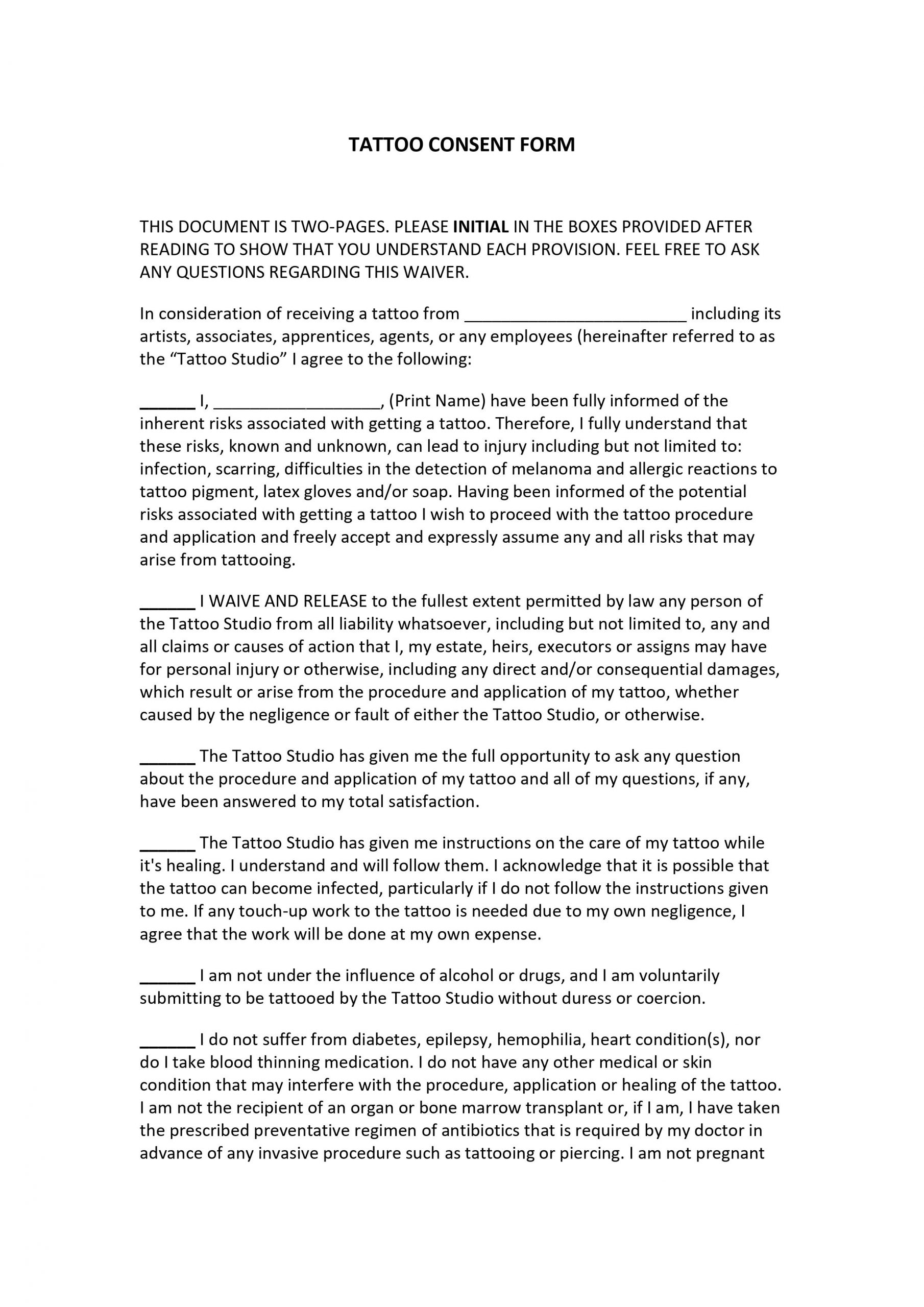- Eviction Notice Forms
- Power of Attorney Forms Forms
- Bill of Sale (Purchase Agreement) Forms
- Lease Agreement Forms
- Rental Application Forms
- Living Will Forms Forms
- Recommendation Letters Forms
- Resignation Letters Forms
- Release of Liability Agreement Forms
- Promissory Note Forms
- LLC Operating Agreement Forms
- Deed of Sale Forms
- Consent Form Forms
- Support Affidavit Forms
- Paternity Affidavit Forms
- Marital Affidavit Forms
- Financial Affidavit Forms
- Residential Affidavit Forms
- Affidavit of Identity Forms
- Affidavit of Title Forms
- Employment Affidavit Forms
- Affidavit of Loss Forms
- Gift Affidavit Forms
- Small Estate Affidavit Forms
- Service Affidavit Forms
- Heirship Affidavit Forms
- Survivorship Affidavit Forms
- Desistance Affidavit Forms
- Discrepancy Affidavit Forms
- Career Assessment - 16+ Examples, Format, Tips, Pdf Forms
- Undertaking Affidavit Forms
- General Affidavit Forms
- Affidavit of Death Forms
Tattoo Consent Form
You could be a proud owner of a new tattoo, but do not let this pride hinder you from carefully thinking about permanent body art. Before getting a tattoo or two, learn the possible risks and how to reduce them. That is why a tattoo consent form is necessary, especially for minors seeking body inking. Learn more about this form and how it eases the process of getting a tattoo. Continue reading this article. Read More
What Is a Tattoo Consent Form?
A tattoo consent form is a document that allows an individual to undergo permanent body art procedures. Sometimes, adult and minor clients have separate consent forms because the requirements are different per location. For minor customers, their parents must consent them and be present during the procedure (and notarized if the state requires). Although some states have a different stand on this, it is best to let your parents know beforehand. Moreover, this document also releases the artist’s legal and financial liabilities if accidents occur while tattooing their clients.
How Do You Prepare a Tattoo Consent Form In Four Easy Steps?
Tattoos have more profound sentiments than what we think. It symbolizes people’s experiences, emotions, adventures, misadventures, and more. Meanwhile, to ink the skin, the artist will use a machine similar to a sewing machine to pierce the skin several times. It does not only put the client at risk but the artist as well. According to Mayoclinic.org, allergic reactions, skin infections, bloodborne diseases, and Magnetic Resonance Imaging (MRI) complications could harm the skin because of the tattoo. Thus, the need for a tattoo consent form. Here is a step-by-step guide to help you craft a tattoo consent form in PDF and MS Word file formats. More on this below:
1. Introduce the Parties Involved
First off, start the tattoo consent form by introducing the parties involved. Provide the names of the individual or the studio that will perform the procedure. Ensure that these details are factual because it is meant to inform the client (or patron) about the health risks associated with getting a tattoo. If the patron agrees to proceed, aside from stating their names, ensure that they sign their initials on the form. Their initials could be a countersign indicating their full understanding of the consent.
2. Indicate the Use of Initials
Although the parties have to sign the tattoo consent form later on after they agree on its terms, it is essential to sign their initials to prove they acknowledge each consent’s provision. As mentioned in the first step, an initial can be a countersign or an autograph that ratifies the tattoo arrangement. Thus, a signature or simple name initials are acceptable. More so, the stipulation must be provided by the consent form’s author. On the other hand, the patron can equally request additional provisions that will enhance the document’s interest.
3. Discuss the Terms and Conditions
The terms and conditions are crucial when it comes to tattoo consent forms. This part will liberate the tattoo artist from any liability if the patron is harmed because of unforeseen accidents during the tattoo procedure. Additionally, it gives both parties opportunities to ask questions likewise to answer them.
Apart from ensuring that the tattoo artist is not under the influence of drugs or alcohol, the terms and conditions must instruct the patron on how to take care of their skin while it is healing and indicate the client’s medication if there is any. You can also add other policies like no refund, variations of color, photograph release, and meaning or symbol of spelling or text. As much as possible, use simple wording so that the provision is easy-to-understand.
4. Sign and Notarize the Consent Form
Lastly, the client must sign the tattoo consent form above their printed name. Provide their date of birth, address (street, city, and state) and describe the identification type they are using as well. If your state requires to notarize the form, consult with a notary public. In that case, provide a notary acknowledgment below the consent form. This is also your chance to validate the legitimacy of the form. Sometimes, some specific legal claims require a separate consent form if the patron is minor.
Frequently Asked Questions
Can my friend sign for me to get a tattoo?
If you are a minor, a friend can sign up for you to get a tattoo as long as he or she is your legal guardian. It is still best to let your parents sign up a consent form to get a tattoo or piercing.
What state outlaws tattoo?
The state of Oklahoma was last to holdout tattooing. However, on November 1, 2006, getting a tattoo is legal in all US states. But, there may be local laws, not under the state tattooing laws, that will determine whether you can get a tattoo in your hometown.
Is it illegal to give yourself a tattoo?
No, it is legally permissible to give yourself a permanent tattoo. However, you can not tattoo others if you are untrained. With that, a tattoo artist must be supervised by a certification or a license.
Tattoo artists take pride in their work. And for a client, getting a tattoo is more than just a decoration for the body. However, we should be aware of its risks, particularly to our health. To protect us from getting harmed during and after a tattoo procedure, sign a tattoo consent form. With this, we won’t worry about something other than enduring the pricking sensation from the tattoo machine.

